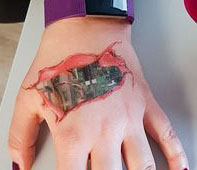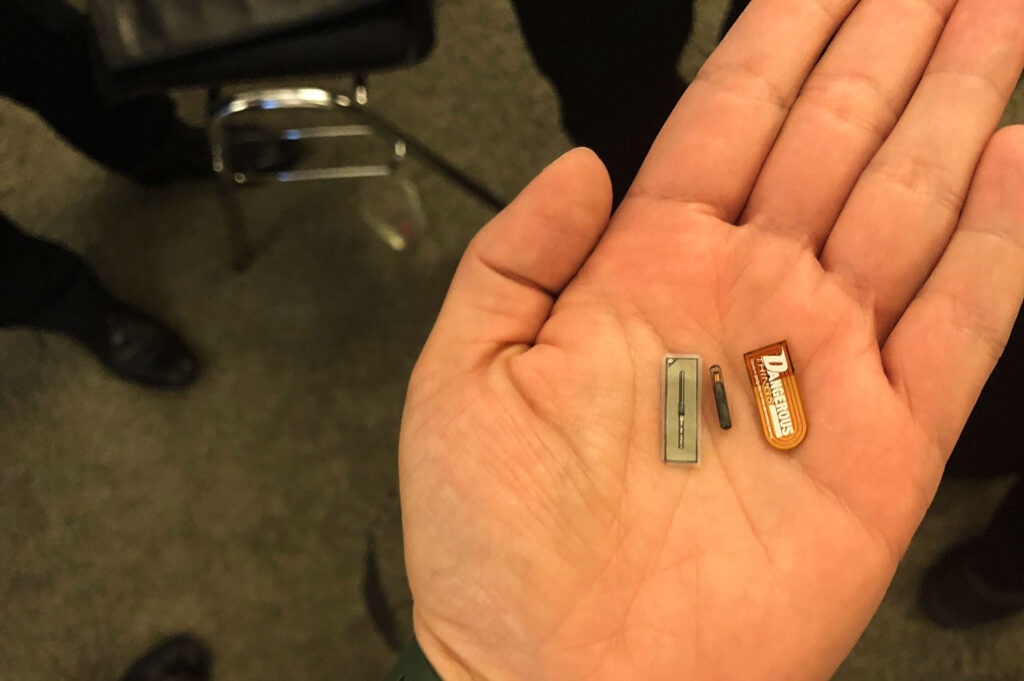This really gets under your skin
Microchips as implants in the era of digital transformation:
Opening doors without keys, always having your ticket with you, and a business card “at hand” anytime — at the 2018 Kontiki conference in Münster, three volunteers had a microchip implanted in their hand. After five months as a cyborg, our colleague Diana Schlee draws her first conclusions.
At the Kontiki conference in Münster in June 2018, Dr. Patrick Kramer, CEO and Chief Cyborg Officer of Digiwell, gave a presentation on the topic of chips as implants. His presentation was exciting, wild, and somehow quirky — which is partly because we Germans tend to be skeptical about such topics at first. In Sweden, several thousand people have already had a microchip implanted and use it as an electronic transit pass or digital payment method. Despite my skepticism, my hand went up when he asked in the workshop if anyone wanted to have an RFID chip implanted. Less than five minutes later, the rice-grain-sized chip was in my left hand between thumb and index finger, and I became a cyborg*.
First disappointment set in
The day after the implantation, I was able to save my business card and links to my social networks on the chip, which now anyone with an NFC-enabled smartphone can read — if I offer them my hand. A few weeks later, the service technician for our office locking system came by — my chance to link the chip to the system and hand over the transponder. Unfortunately, this was unsuccessful; my chip is not compatible with the locking system. We also couldn’t establish a connection with our ticket vending machine, as the NFC reader was unable to find my chip.

The Big Misconceptions
Nevertheless, this chip sparks plenty of conversation at trade fairs or in private settings. Many people react shocked or joke whether I have registered with Tasso (which is the platform for chipped pets 😉) and fall for the usual misconceptions.
Misconception #1: Now everyone knows where I am at all times.
That’s of course not true. With the implant, I cannot be tracked because the microchip has no power source of its own and cannot send out GPS data.
Misconception #2: I beep when I go through a security checkpoint.
When I go through airport security, I don’t trigger any alarms because the microchip implants contain too little metal.
Misconception #3: I can be hacked now. The implant can be written to with an NFC app, but direct skin contact is required. No one can change or read the contents on my chip remotely. Also, the implant can be protected with a password.
Conclusion on Digital Transformation:
Even though I cannot unlock our office door or the ticketing system with the chip yet, I would still consider getting it implanted again. However, I would wait a few more years until there are standardized industry norms, products, and companies that could benefit from it. From experience, it usually takes several years for such standards to establish, as technological transitions often involve high investment costs. Until large companies see clear advantages, there won’t be NFC-enabled readers in trains, retail stores, and other places. Nevertheless, the topic of digital transformation is ever-present, even though many remain skeptical. We keep encountering it in series like BLACK MIRROR or HUMANS.

Not too long ago, no one would have believed that we would all own a smartphone to handle everyday tasks. Nobody needs to go to the bank anymore for transfers, I order my new winter coat online, and I can conveniently book holidays or train tickets from anywhere using my smartphone. So what’s wrong with eventually paying with chips in our hands or always having our electronic ticket with us? No one would accidentally ride without a ticket anymore or have a problem if they forgot their wallet at home. Either way, the implant always sparks discussion and interesting conversations.
*A cyborg (from English “cybernetic organism”) is a living being that is technically augmented or enhanced. It is a form of human enhancement. (Gabler Business Dictionary)

